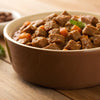How Often Should I Feed My Senior Dog Wet Food? A Comprehensive Guide
- Houndsy
Table of Contents
- Introduction
- Understanding the Nutritional Needs of Senior Dogs
- Benefits of Wet Food for Senior Dogs
- How Much Wet Food to Feed a Senior Dog
- Tips for Making Mealtime Enjoyable for Senior Dogs
- Conclusion
Introduction
Have you ever stopped to consider the twist that an aging dog might have on mealtime? According to the Association for Pet Obesity Prevention, nearly 59% of dogs in the United States are classified as overweight or obese. This statistic becomes even more concerning when we think about our senior dogs, whose nutritional needs shift more significantly as they age. Mealtime can quickly become a delicate balancing act; as pet parents, we want to provide the right nutrition for our precious companions while also considering their changing appetites, digestion, and health.
In this article, we’ll explore how often we should feed our senior dogs wet food, along with essential factors to keep in mind for optimal nutrition. By the end of this guide, we will enable you to confidently adjust your senior dog’s diet to ensure it meets their unique needs, promoting overall health and happiness throughout their golden years.
Let’s reflect on your current feeding routine: is your senior dog getting the nutrition and care they need as they age? Join us as we delve deeper into the appropriate feeding practices for our cherished senior furry friends.
Understanding the Nutritional Needs of Senior Dogs
As our dogs enter their senior years, their metabolism slows down, and their activity levels generally decline. These changes necessitate alterations in their diets to accommodate their evolving health requirements. Here are some essential factors to consider in adjusting their nutritional needs:
Age and Size
The age definition of a senior dog can vary based on size and breed:
- Giant breeds (like Great Danes) may be considered seniors by age 7.
- Large breeds (like Labradors) reach senior status at 8 years.
- Medium breeds (like Beagles) start becoming seniors around 10 years old.
- Small breeds (like Chihuahuas) can stay youthful until around 11–12 years.
As a general guideline, most dogs often transition into their senior diets by the age of 7 or 8, but it’s essential to consult your vet as this can differ based on the dog's size and breed.
Weight Management
Weight management is crucial as dogs age. Senior dogs are at an increased risk of obesity, which can complicate health issues like arthritis, diabetes, and heart disease. Keeping them at a healthy weight is vital—ideal body weight varies by breed and size—so regular vet check-ups are essential to assess and determine the right weight targets.
Special Health Considerations
Senior dogs may experience a variety of health challenges, including:
- Dental issues: Aging can lead to dental diseases, impacting their ability to chew hard food.
- Joint problems: Conditions like arthritis can hinder mobility and affect activity levels.
- Digestive changes: An aging digestive system may require easily digestible and high-moisture foods.
Understanding these concerns will help you tailor your senior dog's diet to their specific health needs.
Benefits of Wet Food for Senior Dogs
Wet food can be an advantageous option for senior dogs for multiple reasons, allowing us to address these unique dietary needs effectively:
Enhanced Palatability
Many older dogs tend to become pickier eaters. The aroma and taste of wet food usually entice even the fussiest eaters. If your senior dog seems disinterested in dry kibble, a wet food alternative could reinvigorate their appetite and encourage them to eat.
Improved Hydration
Senior dogs are more susceptible to dehydration, especially those with mobility issues. Wet food, with its high moisture content, helps keep them hydrated, contributing to overall health. This is especially important for dogs prone to urinary tract issues or kidney problems.
Nutrient Density
Wet dog food often contains higher protein content and fewer fillers compared to dry kibble. This nutrient density can be beneficial for senior dogs, providing the quality ingredients that support their aging bodies. Look for wet foods formulated for seniors that include crucial ingredients like glucosamine for joint health and antioxidants for immune support.
Easier to Chew
For dogs experiencing dental issues, wet food provides a soft texture that is gentler on their teeth and gums. This ensures they receive the nutrients they need without discomfort, making it easier for them to enjoy their meals.
How Much Wet Food to Feed a Senior Dog
Determining the appropriate amount of wet food to feed your senior dog can sometimes feel overwhelming, but there are several guidelines that can help simplify this process:
General Guidelines
A good rule of thumb is to feed your senior dog approximately 2% of their body weight in food daily. For example, if your senior dog weighs 50 pounds, they should receive about 1 pound (or approximately 16 ounces) of food each day.
Reading the Feeding Guidelines
Always check the feeding guidelines provided on the packaging of the wet food you choose. Many brands recommend feeding a specific number of cans based on your dog's weight. Here’s a common breakdown of wet food feeding guidelines:
- Up to 10 pounds: 1/2 can per day
- 10 to 20 pounds: 1 can per day
- 20 to 30 pounds: 1.5 cans per day
- 30 to 50 pounds: 2 cans per day
- 50 to 70 pounds: 2.5 cans per day
- 70 to 90 pounds: 3 cans per day
These guidelines can vary based on your dog's activity level, health status, and specific dietary needs, so it's important to adjust as necessary.
Adjusting Portions for Mixed Diets
If mixing wet food with dry kibble, make sure to adjust the portions accordingly to prevent overfeeding. For every cup of wet food you add, reduce the dry food by about 1/3 cup. This helps maintain a balanced caloric intake.
Monitoring Weight and Adjusting as Needed
Regularly check your senior dog’s weight and body condition over time. Any unexpected weight gain or loss should prompt a reevaluation of their food portions. Consulting with your veterinarian will help ensure you're meeting your dog's specific needs.
Tips for Making Mealtime Enjoyable for Senior Dogs
Transitioning to a new diet may take time for senior dogs, but creating a positive mealtime experience can greatly enhance their enjoyment and interest in food. Here are some tips to consider:
Serve Room Temperature Food
Serving food at room temperature can increase palatability. If the wet food has been stored in the refrigerator, allow it to sit at room temperature for a while before serving, or briefly warm it up (but be careful not to overheat).
Provide a Comfortable Feeding Space
Ensure that your senior dog’s feeding area is comfortable and quiet. If they have mobility challenges, consider using a raised food bowl to reduce strain on their joints while eating.
Consider Frequent, Smaller Meals
To accommodate a potentially decreased appetite and slower metabolism, consider feeding smaller portions throughout the day rather than one or two large meals. This method can also alleviate hunger-related digestive issues.
Keep Fresh Water Accessible
Ensure that your senior dog always has access to clean, fresh water. Place water bowls at convenient locations around your home, especially if mobility is an issue.
Monitor Their Eating Habits
Keep an eye on your dog’s appetite. If they suddenly refuse to eat, show interest in the food, or have difficulty eating, consult your veterinarian to rule out underlying health conditions.
Conclusion
Feeding a senior dog the right amount of wet food is essential for maintaining their health and vitality as they age. By understanding their unique nutritional needs, leveraging the benefits of wet food, and applying appropriate portion guidelines, we can ensure our furry companions enjoy a nutritious and fulfilling diet.
At Houndsy, we're committed to elevating the dog-feeding experience to make it convenient, beautiful, and enjoyable for both pets and their owners. Our signature product, the Houndsy Kibble Dispenser, offers ergonomic convenience and design excellence, allowing you to easily serve the perfect portion of food without the hassle of bending down. With its large storage capacity and an innovative auto-locking mechanism, our dispenser revolutionizes feeding time and enhances your pet care routine.
Reflect on your feeding habits and think about how you can enrich your senior dog’s mealtime experience with wet food. Together, let's prioritize their nutrition and overall well-being as they navigate their golden years.
FAQ
1. How do I know if my senior dog is overweight?
To assess whether your dog is at a healthy weight, check their body condition score (BCS). You should be able to feel their ribs without excessive fat covering, and they should have a defined waist when viewed from above. If you have concerns, it's best to consult your veterinarian.
2. Can I mix wet and dry food for my senior dog?
Yes, mixing wet and dry food can provide variety and stimulate appetite. Just ensure that you adjust the portions accordingly to avoid overfeeding.
3. How often should I feed my senior dog?
Feeding schedules vary, but most senior dogs do well with two meals a day. However, some may benefit from smaller, more frequent meals. It's essential to monitor your dog's appetite and adapt the feeding routine as necessary.
4. What should I do if my senior dog refuses to eat?
Loss of appetite can have various causes, from dental issues to underlying health problems. If your senior dog refuses to eat, consult your veterinarian to rule out medical concerns and explore alternative food options.
5. How much wet food should I feed my senior dog?
On average, senior dogs should receive approximately 2% of their body weight in food per day. However, always refer to the specific feeding guidelines on the wet food packaging for precise recommendations tailored to that particular brand.
By following these guidelines and considering your senior dog’s unique needs, you can help ensure they enjoy a happy and healthy life as they age.













